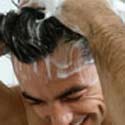“No,” he simply replied.
“You have some kind of rash on your scalp.” I avoided using the word “dandruff.” Children don’t get dandruff. Only adults do, I thought.
That night, I applied cortisone cream, which we always kept handy, on the scaly patches on his scalp. Reggie always had a quite sensitive skin – from cradle cap when he was still a baby, to rashes behind ears, elbows and the back of the knees. And now, he had flakes on his scalp.
Every night, for about a week, I diligently applied cream to the scaly patches. He sat on the floor above me while I sat on the side of the bed. It was the most convenient position to apply cream on his scalp, as he has grown taller than me. I meticulously combed my fingers through his straight, coarse hair, held the parted hair with my left hand, while I squeezed with my right hand the tube of cream and dab a small amount on every crust, making sure that I didn’t miss a single spot. The task may have been painstaking, but deep inside me, I felt a sense of comfort. I haven’t been this close to my first-born for a long time.
Over the last few years, I had been very busy attending to his two younger and more demanding brothers that I didn’t realize until then how much I missed holding him. Oh! How much I held him when he was still a baby! And he was my baby for four and a half years. Then his brother Ryan was born. “You’re a big boy now, Reggie,” I coaxed him to do some things on his own. Another four years passed and his brother Ryland came. “You’re old enough to take a bath by yourself.” I taught him to be more independent.
Reggie used to be so bubbly, talkative, and inquisitive, like my 6-year old son, Ryland. As he grew older, he has become quieter and reserved. He used to talk about the things that happened in school. Now, when I ask him anything, he just answers “Yes” or “No.” The first and only time he uttered the words “I don’t want to talk about it,” I choked back my emotions.
With little improvement on his scalp after a week, we went to see Dr. Deonarine, our pediatrician.
“Is it dandruff?” I eagerly asked her after a brief physical exam.
“It’s seborrhea,” she said looking at me.
“How did he get it?” I anxiously asked her.
“Did he recently change the shampoo that he is using?” She threw a question back at me.
I shook my head.
“It could just be his changing body. He’s a teen-ager now. His skin gets oily and that causes seborrhea,” she explained.
She then turned to Reggie and asked him, “Do you use products on your hair?”
I saw the puzzled look on his face.
“Mousse? Hair gel?” she continued.
His face lit up and replied embarrassedly, “Oh, yeah.”
I saw the tiny white crumb-like stuff on the back of the navy blue sweater as he got up after shutting down the computer. White flakes on a dark shirt used to be a common sight a few years ago, before my husband treated his dandruff. But this guy, who was five feet and two inches tall, was not my husband. This was my fourteen-year old son.
“What is that on your sweater, Reggie!” I blurted out as I flicked with my fingers the white flakes under his neck. I parted his thick black hair in different areas to confirm my suspicion. I saw patches of crusty scales. “Did that hurt?” I asked him when I scratched off some of it and more flakes fell on his sweater.
The next day, I went to the store, headed to a frequented aisle, and grabbed the familiar white and blue box with the small pink circle in the centre. I perused the label as if I was reading it for the first time: “Nizoral 2% Ketoconazole Anti-Dandruff Shampoo. Kills the Fungus That Can Cause Dandruff and Seborrhea.” Holding the box of shampoo in that aisle snapped me out of my state of denial. My son was no longer a child, and he had dandruff. I guess I already knew that when his voice suddenly cracked and began to sound deep on the week of his 13th birthday. Yes, my dear boy was slowly turning into a young man.
Reggie started using Nizoral and we switched to Elocom lotion. I looked forward to applying the lotion on his scalp every night and striking up short conversations with him. Him – my teen-ager who barely talked to me anymore. He had become so independent and yet there he was relying on me to apply cream on his dry scalp. It may be an unglamorous way of bonding with him, but I’d take it. After a few weeks of treatment, the seborrhea was gone.
Once in a while, I would run my fingers through his hair and check if the seborrhea had come back. It hasn’t ever since. I talk to my boys regularly. I always have. And although I get more responses from his brothers, Reggie has begun to open up more than he did before.
Originally written on July 2004
Posted on March 2006





